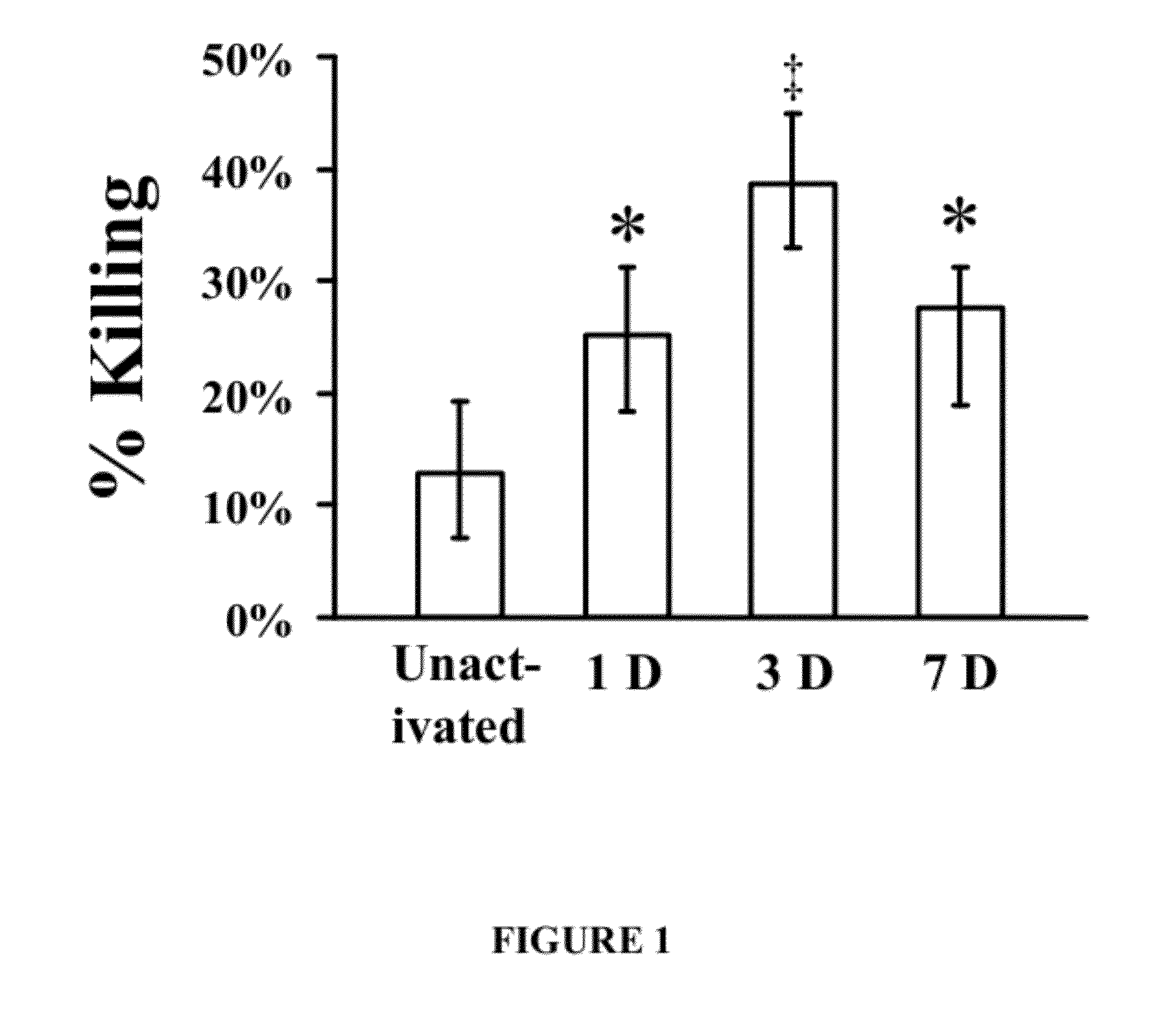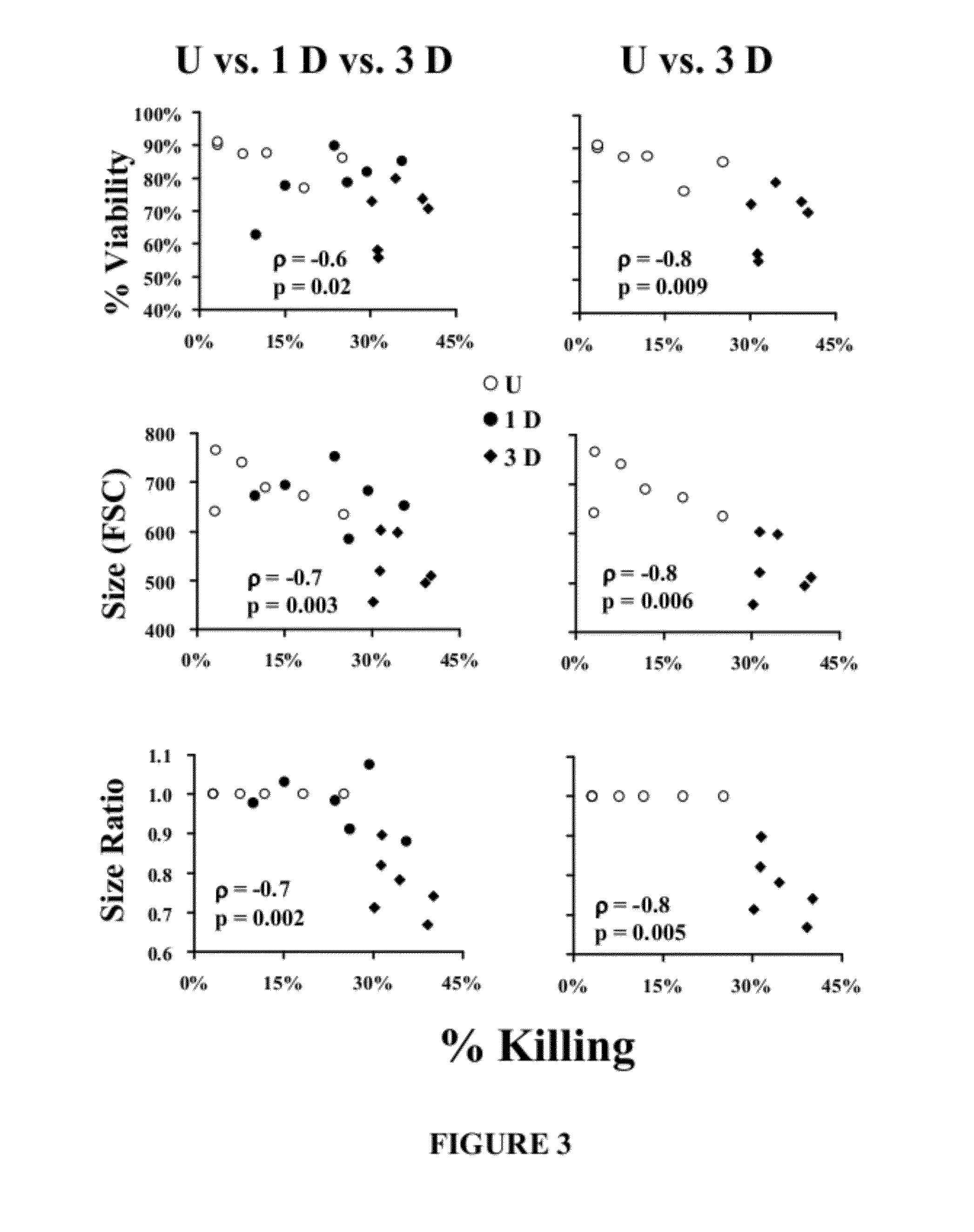Methods for treating refractory infections in neutropenic individuals
a neutropenic and refractory technology, applied in the direction of biocide, drug composition, extracellular fluid disorder, etc., can solve the problems of neutropenia being a major risk factor for the development of disseminated candidiasis, i>is a major cause of morbidity and mortality in patients with cancer, and the attributable mortality of disseminated candidiasis is unacceptabl
- Summary
- Abstract
- Description
- Claims
- Application Information
AI Technical Summary
Benefits of technology
Problems solved by technology
Method used
Image
Examples
example i
Shortened Activation of HL-60 Cells Resulted in Equivalent to Superior Killing of C. albicans
[0054]This example demonstrated that shortened activation of HL-60 cells can result in superior candidacidal activity.
[0055]As a marker of safety, HL-60 cells and cell supernatant were tested commercially (Focus Laboratories, Cypress, Calif.) for a variety of human pathogenic viruses (Table 1). No evidence of viral infection was found.
TABLE 1No evidence of common viruses in HL-60 cells.VirusTestResultHTLV 1PCRNot detectedHTLV 2PCRNot detectedHCVRT-PCRNot detectedHBVPCRNot detectedHIVUltrasensitive RT-PCRNot detectedHHV-6PCRNot detectedHHV-7PCRNot detectedVZVPCRNot detectedCMVPCRNot detectedEBVPCRNot detectedHTLV = human T lymphocyte virus; HCV = hepatitis C virus; HBV = hepatitis B virus; HIV = human immunodeficiency virus; HHV = human herpes virus; VZV = varicella zoster virus; CMV = cytomegalovirus; EBV = Epstein Barr virus
[0056]It was previously reported that activation of HL-60 cells fo...
example ii
Viability and Flow Cytometric Parameters Reliably Distinguish Unactivated from Activated HL-60 Cells
[0064]This example demonstrated that unactivated HL-60 cells can be reliably distinguished from activated HL-60 cells by viability and flow cytometry.
[0065]Given the need to ensure adequate activation of HL-60 cells from experiment to experiment, several cellular parameters were explored as potential quality-control markers of activation. Concordant with prior results using seven day activated cells (Spellberg et al., J Leukoc Biol. 78:338-344 (2005), it was found that continuous activation of the cells in the presence of RA and DMSO resulted in differentiation of the cells and a progressive decrease in cell viability starting after day one of activation. By day three of activation, HL-60 cell viability was significantly and reliably decreased as compared to unactivated and one day activated cells (FIG. 2a).
[0066]During cell counting, it was noted that activated HL-60 cells appeared s...
example iii
Flow Cytometric Parameters can Predict HL-60 Cell Candidacidal Capacity
[0071]This example demonstrates that flow cytometric parameters correlate with HL-60 candidacidal capacity.
[0072]To determine if the parameters that distinguished unactivated from activated HL-60 cells correlated with candidacidal capacity, the above cellular parameters were measured before performing kill assays with the same cells. Cell viability, cell size, and change in cell size during activation all inversely correlated with anti-candidal activity, regardless of whether all groups were compared or just unactivated versus three-day activated cells were compared (FIG. 3).
[0073]FIG. 3 demonstrates that HL-60 viability and cell size correlate with anti-candidal killing activity. Immediately prior to performing anti-C. albicans kill assays, viability (trypan blue exclusion) and flow cytometry parameters were determined on Unactivated (U) HL-60 cells or HL-60 cells activated with RA and DMSO for 1 or 3 days (1D, ...
PUM
| Property | Measurement | Unit |
|---|---|---|
| time | aaaaa | aaaaa |
| time | aaaaa | aaaaa |
| time | aaaaa | aaaaa |
Abstract
Description
Claims
Application Information
 Login to View More
Login to View More - R&D
- Intellectual Property
- Life Sciences
- Materials
- Tech Scout
- Unparalleled Data Quality
- Higher Quality Content
- 60% Fewer Hallucinations
Browse by: Latest US Patents, China's latest patents, Technical Efficacy Thesaurus, Application Domain, Technology Topic, Popular Technical Reports.
© 2025 PatSnap. All rights reserved.Legal|Privacy policy|Modern Slavery Act Transparency Statement|Sitemap|About US| Contact US: help@patsnap.com



